Identifying an antique desk style is not an easy task. Human history has witnessed many different types and versions. From the earliest Bureau Mazarin to the Victorian Wooten, the list of antique desks is almost never-ending.
And so, if you walk into a store to buy or sell one, chances are you’ll be pretty much confused yourself. For an antique collector, this can be quite an embarrassing moment. Trust me; we’ve all been there!
But, worry no more because we’re here to help. In today’s post, we’ll talk about identifying antique desks with pictures in detail. So, let’s dive in and enlighten ourselves!
Table of Contents
What is an Antique Desk?
A desk is a piece of furniture with a flat, table-like surface. It allows you to write, read, and draw comfortably. Many models also feature drawers and cabinets for supply storage.
But, what classifies it as an antique desk?
An antique desk refers to a desk from the 1800s to the 1900s and before. It should be at least 100-years old. Anything less than that will qualify as a vintage or retro desk.
Here are a few features of an original antique desk:
- The old wooden structure will have marks, scratches, and a chipped surface. It’s impossible for an antique desk to have a smooth, polished, and undamaged exterior after so much time.
- Uneven and imperfect dimensions are highlights of an antique. It reflects the lack of resources and technology in the past.
- The manufacturer’s nameplate will be on the front or back. It should be made of steel, brass, or any other common metals. Some desks will feature deeply engraved company names with production date and model numbers.
- The term bureau is used in antique desk paperwork, product title, or nameplate. Bureau is an ancient word that people used around the 1700s for desks.
- The construction includes high-quality woods like Mahogany, Cherry, Oak, Walnut, and Pine. These woods were commonly used back in time. However, today, the construction industry prefers wood that is more easily available and cheap, like Maple.
- Victorian-style hand carvings might be present on the drawers and legs.
3 Main Types of Antique Desks
Generally, a desk is a multi-purpose furniture item. The modern design makes it suitable for a variety of tasks like reading, writing, and even crafts. As a result, people end up saving money and conserving world resources.
However, back in time, things weren’t so efficient. People made specialized desks for different purposes. And so, you’ll come across a broad range of antique desk types.
Here are the three main types to identify:
1. Writing Desks
As the name explains, the antique writing desk was designed especially for writing books, documents, and everything in between. These tables featured smooth, flat surfaces with plenty of space to rest your arms. There were also cabinets, drawers, or shelves to store writing supplies.
2. Library Tables
The library tables resembled the writing desks a lot. However, their main purpose was different. It was to provide an area for book placement to readers at the library.
So, the tables were narrower than desks. They had vast open space below the table with pedestal corner legs. A few library tables featured a maximum of two drawers.
All this helped two or more people to sit together and read comfortably.
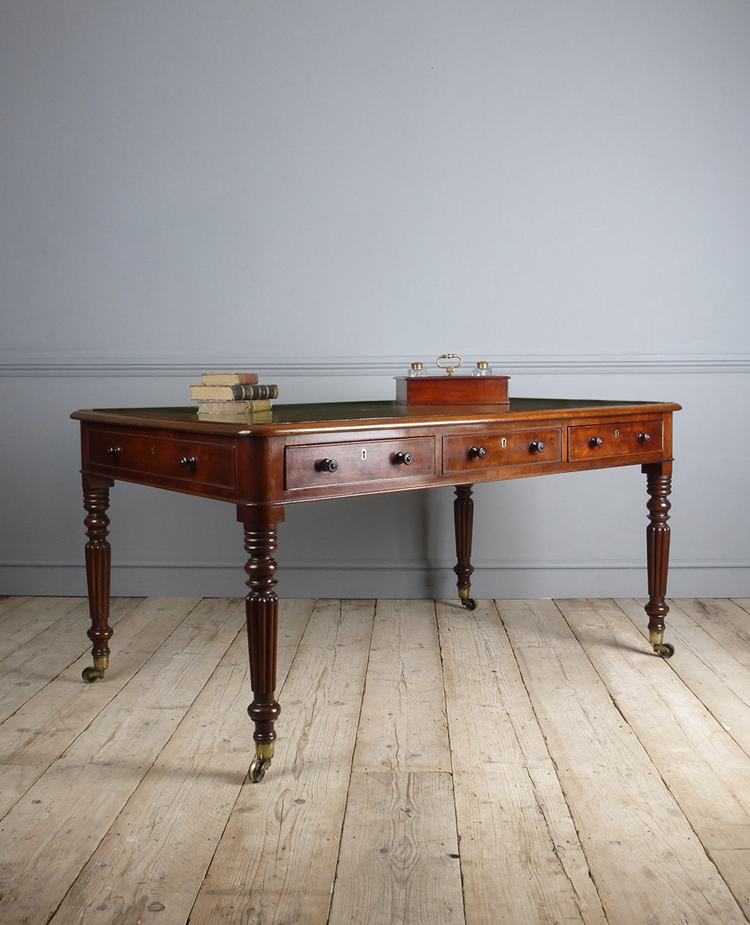
3. School Desks
Perhaps, this is the only antique desk type to be compact and small. The school desks had a classic wooden design with a small writing space attached to the chair. Different schools attached the writing space in different configurations to suit their needs.
Some examples include:
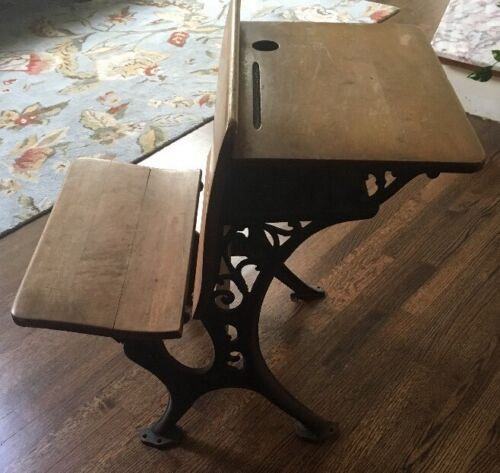
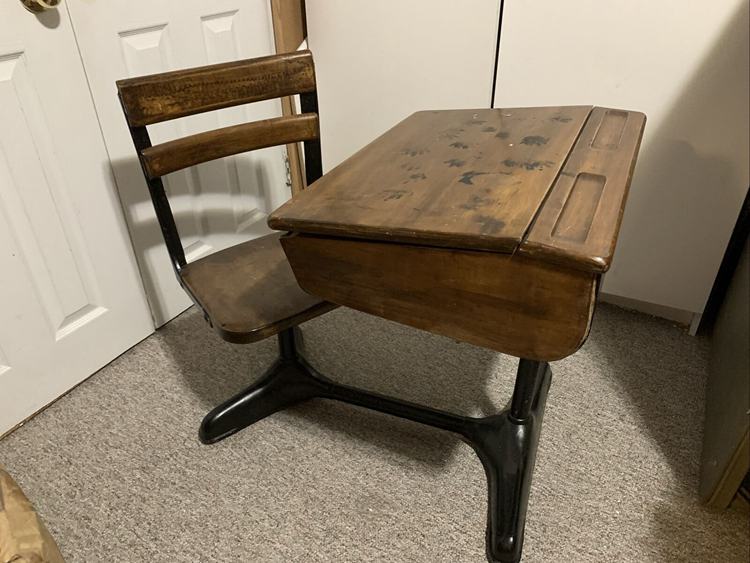
Later, in the late 1800s, a separate desk and chair unit became the trend at schools. This design type is still in use today. However, the wooden material has been replaced by high-strength metals.
13 Famous Antique Desk Styles with Pictures
Desks have been in a constant loop of evolution ever since their invention in the early 15th century. So, there’s no wonder that a wide variety of antique desk styles exist in the market.
Please note: The types of antique desks were primarily categorized based on the purpose. When we’re talking about style, we refer to looks and design. Many antique desk types were available in two or more styles discussed below.
1. Bureau Mazarin
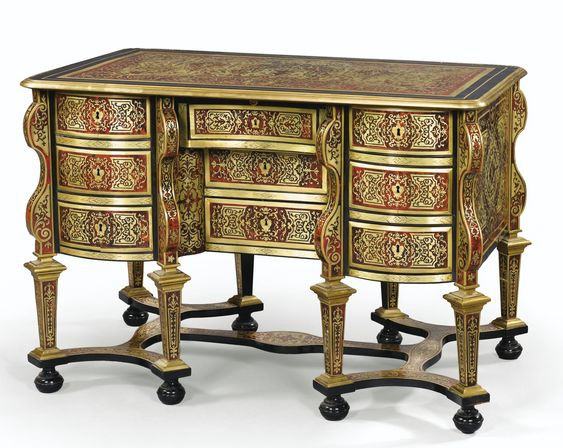
Introduced in the 1600s, the Bureau Mazarin is the oldest antique desk style that you’ll ever find. It was developed in France and is often associated with royal furniture. The term Bureau Mazarin translates to Mazarin’s desk.
If you take a glimpse into the past, it isn’t difficult to notice the relation between Cardinal Jules Mazarin and this desk name. Jules Mazarin was the chief minister to King Louis XIV of France from 1642 to 1661.
Besides, the Bureau Mazarin desks feature lavish Boulle work. The Boulle marquetry also originated from France. Perhaps, all these connection points are enough to prove this desk style to be the oldest in existence.
So, if you find this desk style, know that you’ve found a rare gem. It will have 2 to 3 tiers of small drawers with a narrow central drawer. There will be plenty of space in the center to place your knees and legs.
You will also observe that the desk legs will be either eight or four; connected together with X/H stretchers. Any other number of legs clearly indicates that the desk is a reproduction.
2. Bargueño Desk
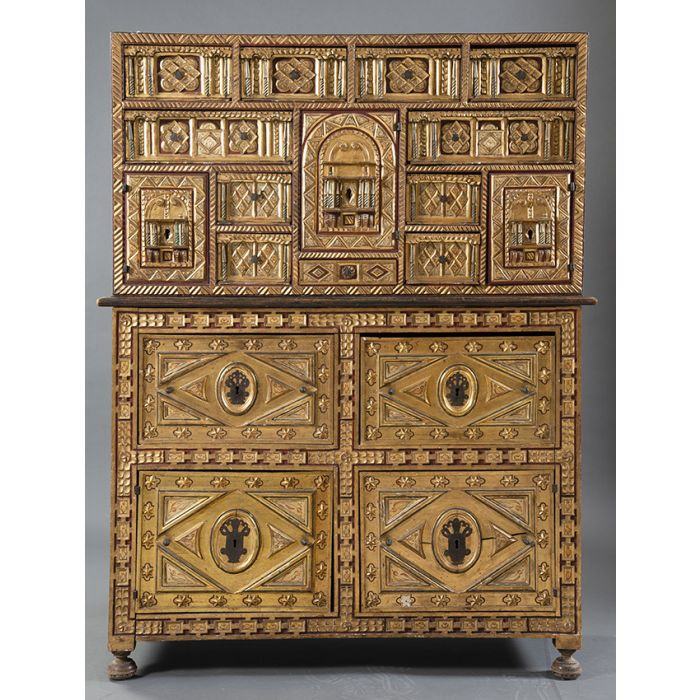
Bargueño literally means Bargas, which is a municipality in Spain. The desk was made during the 15th century when the Spanish Renaissance period first started. Since then, the desk style has remained popular.
It consists of two chests stacked on top of each other. While the bottom chest (taquillón) features multiple drawers, the top one comes with a hinged writing surface. It also doubled as a side-mounting lid.
Inside, the desk has numerous compartments and pigeon holes for ultimate storage space. Many people used this desk as a jewelry and sewing chest too. On the sides, the Bargueño has two solid iron handles for transportation.
But, what really makes this desk style famous is the elaborate design. The Bargueño always has heavily decorated and sculpted exteriors with even more impressive interiors.
3. Bureau a Gradin
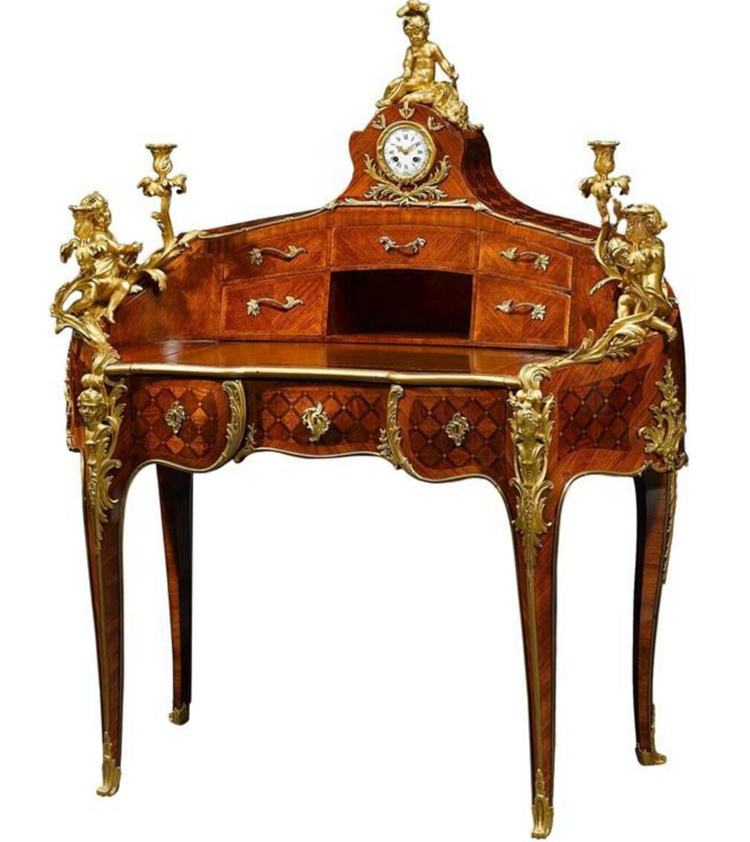
Although Bureau a Gradin doesn’t have a rich history, it is one of the most commonly found antique desks. The writing desk comes with a few tires of compartments and pigeon holes on the surface. All these storage spaces are pushed back so that they directly face the person using the desk.
The legs of the Bureau a Gradin are often curved and decorated. They are sleek and tall to provide ample space for all types of users. However, some versions of Bureau a Gradin are very small, compact, and portable.
Also called Bonheur Du Jour, this form was designed for ladies in the 1760s. One could easily pick them up and move around the room. It’s also why the back and top of the desk have beautiful bronze designs no matter what.
The Carlton House desk is another form of Bureau a Gradin that was specially made for the Prince of Wales in the 18th century. It had the same structure, but there were more drawers that surrounded the sides of the desk in a U-shape. The style soon became a trend, resulting in several antique Carlton House desks.
4. Butler’s Desk
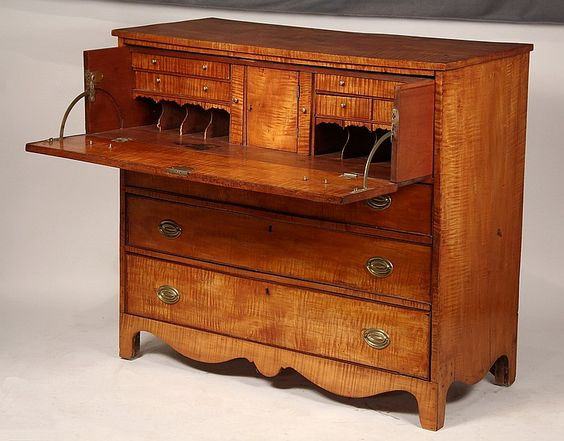
The Butler’s desk has a drop-front design that lets the front hinged panel drop down to create a writing surface upon need. It also reveals several small compartments where you can store high-value items.
Meanwhile, on the lower half, there are usually 2 to 4 huge drawers. So, when you close the front panel, the desk resembles a chest. A few versions may feature cabinets and doors too.
All in all, the Butler’s desk has a compact and plain structure. You won’t find much design since it belongs to the late 18th century. The only decorative elements will be curved feet or spindled galley.
5. Liseuse desk
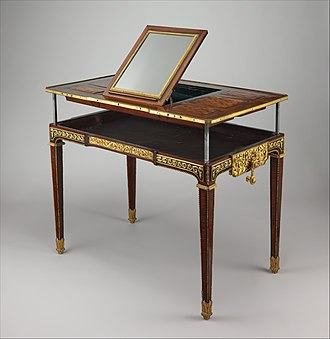
Another French desk style that was very popular during the 18th century was the Liseuse desk. It is a medium-sized table that features a small hinged panel in the center. This particular panel is adjustable.
So, you can prop it up to the desired angle and create a slanted surface for books. Some Liseuse desks even had lateral panels that could be swung open to increase the surface available.
Today, searching for the earliest French Liseuse tables is difficult. However, you will come across several British versions that were produced during the early 19th century.
6. Cheveret
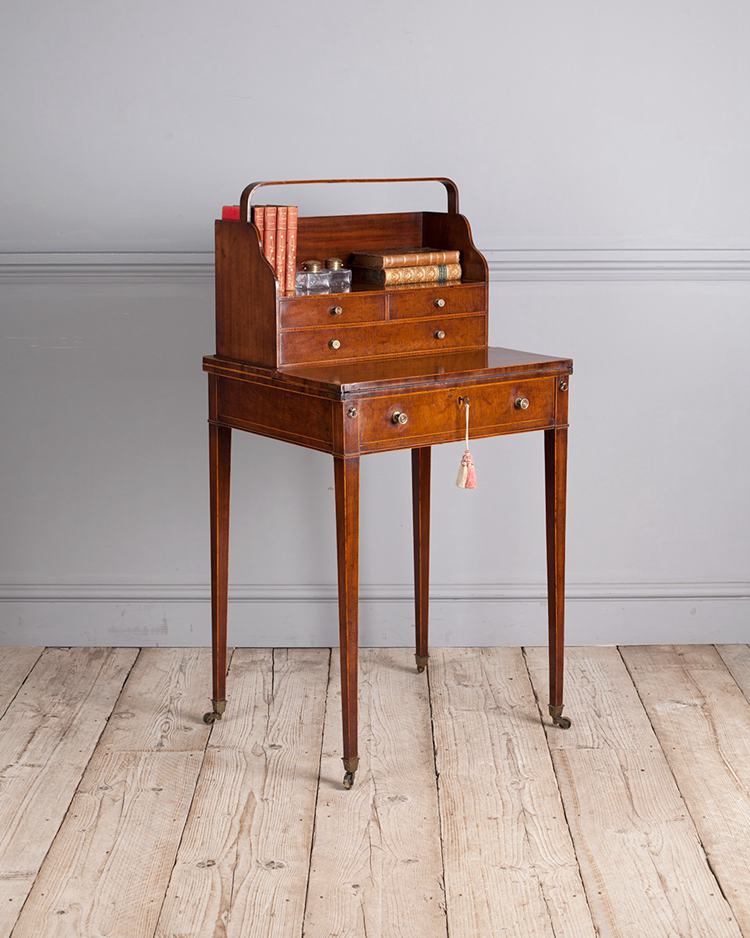
The Cheveret is a very delicate antique desk style that was designed for ladies. It features a small writing surface with a multi-drawer chest or bookcase on the top. There can be a drawer and shelf underneath the desk.
Perhaps, the highlight of the Cheverert desks is the straight and saber-style legs. They give the desk a clean and minimalist look.
7. Davenports
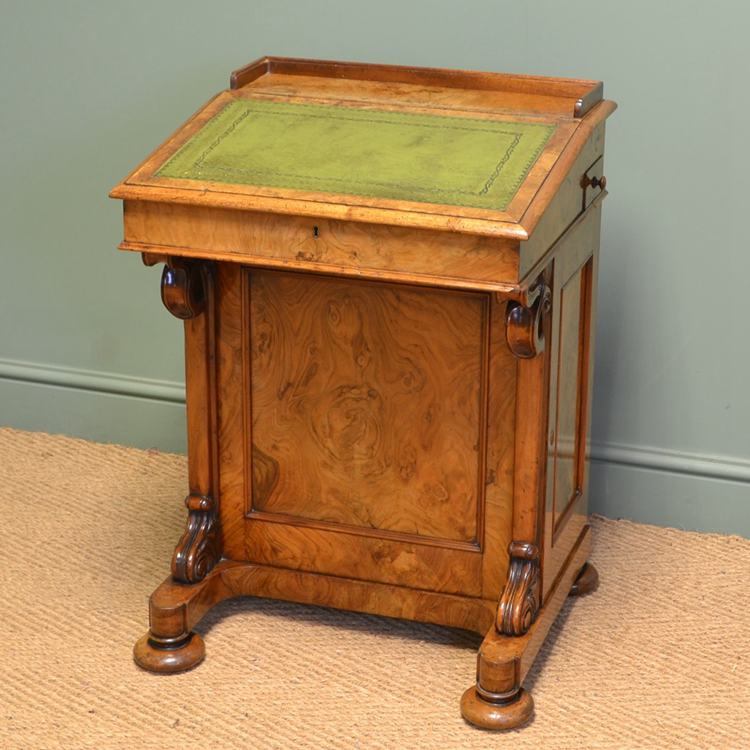
In the 1790s, a British furniture company named Gillows & Co. manufactured a special desk for their client Captain Davenport. The desk had a compact size, slanted top, and multiple compartments at the bottom. It was considered the perfect desk for use on ships and on military campaigns.
Soon, the desk style caught the attention of the masses and became known as the Davenport. Some people called it the Captain’s desk. By the 19th century, it was famous in homes throughout America and England.
Many versions were released by the company. They replaced the bun feet and castor wheels of the desk with ornate cabriole legs. Some Davenport desks had faux drawers, while others had hidden drawers and cubby holes.
8. Escritoire (Secretary)
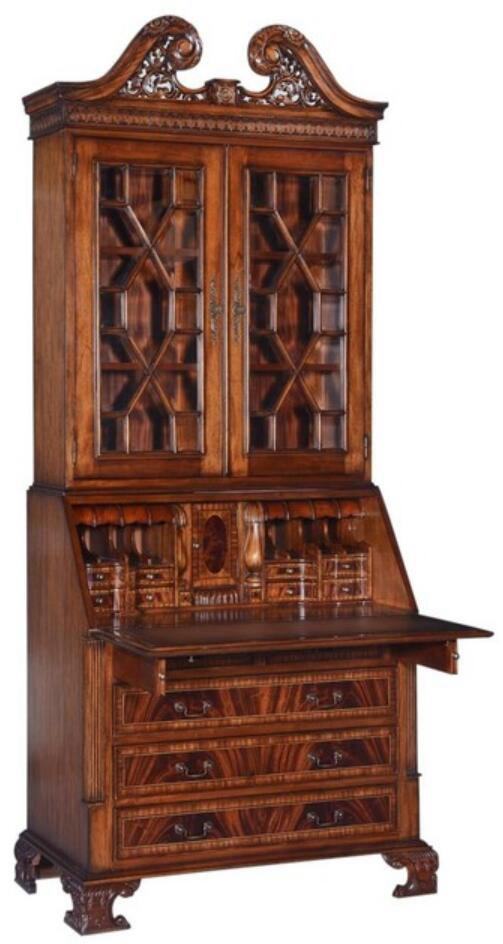
The escritoire or secretary desk is a heavy furniture piece that was introduced in the 1800s. It comprises a chest of drawers with a hinged writing panel on the top and a bookcase above that. The bookcase is typically closed with a pair of doors.
So, at a glance, the antique secretary desk resembles a bookcase and dresser hybrid. The structure is very tall and broad. Mostly, businessmen and literary professionals bought this desk for their offices.
Even today, only expert antique collectors and museums purchase these desks. It’s primarily because the antique secretary desks are too bulky for transportation. Also, it costs thousands of dollars at the least.
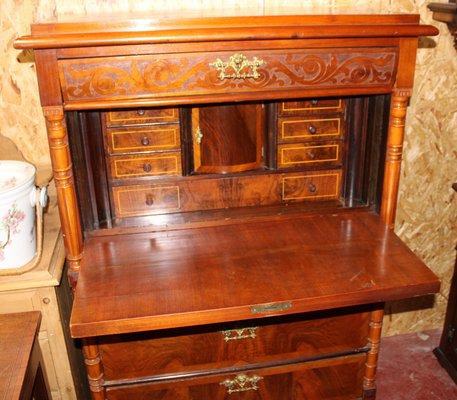
However, you can easily buy escritories that are half their normal height and width. It means they do not have the bookcases on top. These desk styles are called side-by-side secretaries.
9. Kneehole Desks
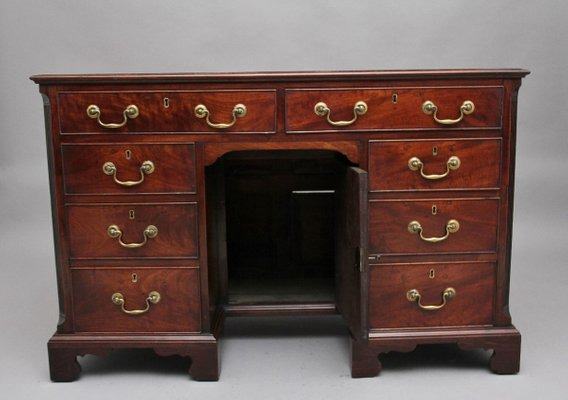
Since the 1700s, the kneehole desk has remained an important part of British culture. These antique desks feature a smooth and flat top with tiers of drawers underneath. Each drawer is short in width but deep to accommodate a lot of stuff at once.
In between the tiers, there is a space vast enough for the user to place his knees easily. This was the main feature that led to the name kneehole desks. You can find this antique style in different designs and patterns.
10. Pedestal Desk
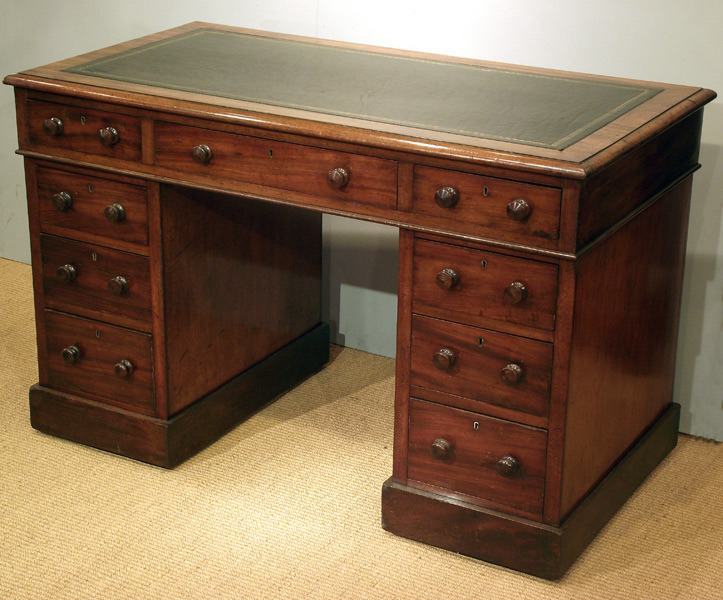
Also called a tanker desk, the pedestal desk refers to the huge, rectangular work surfaces that rested on two pedestals. These free-standing desks offered a wide and flat area to do paperwork with ease.
These desks had one central drawer for storage. Most versions also had cabinets and drawers stacked below. Of course, the increase in storage space meant higher costs too.
The pedestal desks were in great demand since their creation in the 18th century. Soon, it underwent some modifications too.
At first, people added a large leather sheet for improved writing. A pull-out lined drawer was added to the desks with plain, wooden surfaces. Later, in the 19th century, a modesty panel was also introduced.
This particular modesty panel kept the legs of the user hidden from the others. As a result, more businessmen and corporate officials started using it. Nowadays, pedestal desks with glass surfaces and laminated wood are widely used.
11. Partner Desk
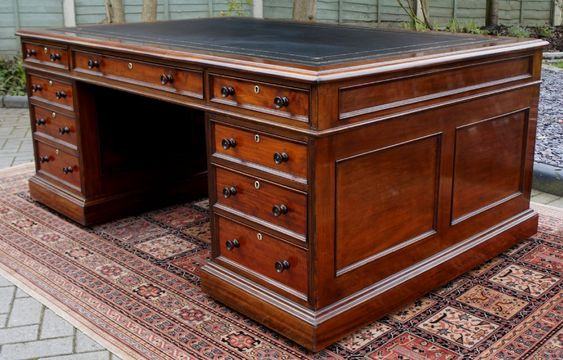
The partner desk was created when the business structure was booming in England. It was around the 18th century during which people formed partnerships and other legal business laws. As the concept was new and trending, furniture makers released this partner desk that allowed two people to use it together.
It is basically a huge pedestal desk with knee holes on both sides. So, two people can face each other and work as partners. There are also sets of drawers on each side.
You’ll find antique partner desks made from high-quality woods like oak, walnut, and mahogany. Since these were essential office furniture, some antiques may feature luxury leather tops and brass fittings too.
12. Roll-top Desk
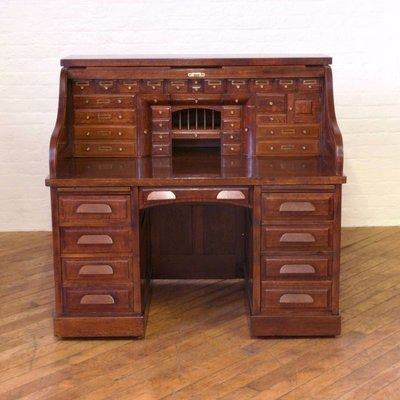
Jean-François Oeben invented a new type of desk style in 1760; the roll-top. It had the typical bureau structure with a chest of drawers at the bottom and a writing surface above topped with a few shelves. However, the unique addition was the roll-top cover.
Flexible slats were fixed on the shelves that were placed on top of the writing surface. These flexible slats formed a cylindrical shutter when rolled down. As a result, people were able to neatly cover the entire writing area and the shelves once done.
This design also ensured things remained clean and dust-free. Jean’s desk style gained instant fame and is still one of the most popular antiques in the market. The wood used in these desks is typically high-end oak.
13. Wooton Desk
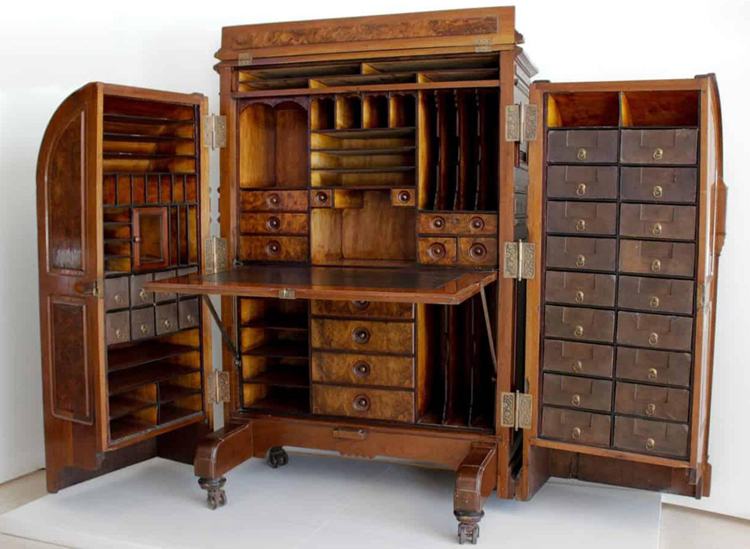
Also called the King of Desks, the Wooten desk is a classic example of the Victorian era. Its massive build and ornate exterior reflect the ancient executive interests.
The four-legged beast is typically wider than the secretary desk style discussed above. Its main body is like a bookshelf but with multiple dozens of drawers. People can store all kinds of things in different-sized compartments.
Its work surface is a hinged panel that can be opened further to increase the area. It can also be lifted and turned vertically to lock the desk. However, the user would have to put away the papers and supplies beforehand.
That said, the main lock-up of the desk is done by closing the two giant hinged panels. These panels are actually shelves fitted with more shelves and holes for storage.
Expert Tips on How to Identify Antique Desks
We’ve already discussed the features of an original antique desk before. However, sometimes, identifying those alone is not enough. You may want to verify the authenticity further before you invest thousands of dollars.
In that case, follow these expert tips on how to identify antique desks:
● Examine the Joinery
The joinery of any wooden furniture is the first giveaway of whether it’s an antique or not. Since machine-cut items weren’t made until the 1860s, the joinery should be handmade. To investigate this, simply remove a few of the drawers.
Look at the front and back areas where the drawer was fastened to the sides. If you find the joints to be unevenly placed, know they were dovetail by hand. The ones done by machine are always precisely cut and placed.
A handcrafted dovetail is a clear indication that the antique is original and probably dates back to the 1860s.
● Look at the Cut Type
The drawer has more to tell us than mere dovetails and joints. It can give us hints about the tools that were used in manufacturing. And so, we can deduce the antique’s originality.
For this, inspect the bottom, back, and sides of the drawers carefully. A wood piece with cuts and nicks indicates the use of primitive tools. These include drawknife, spokeshave, and plane.
Any such antique is likely to be from the early 1800s. However, if you find arc-shaped marks on the wood, know that a circular saw has been used. These antique desks will also be original but from the late 1800s.
All that said, the edges should be rough and imperfect. This doesn’t mean that they won’t be straight. Just a bit distorted and not as precise as today’s furniture.
● Analyze the Wood Finish
The finish on the wood is a quick way to identify an antique desk.
In the earliest times, people used wax, oil, and milk paints to make the wooden surface smooth. Then, in Victorian times, shellac was the go-to option for a clean, finished look.
By the end of the 19th century, furniture makers had widely adopted the use of lacquer and varnish. Today, polyurethane and similar advanced wood finishes are more commonly used.
● Contact a Professional
Last but not least, contact an antique professional to confirm the originality of your old desk. You can request a booking from an appraiser, reputable collector, or reproduction artist.
All these individuals have great experience in studying antiques. So, you can expect some solid guidance about identification and authenticity. If someone is not able to help you, reach out to online antique communities and organizations.
Here’s a list of the best professional help:
Frequently Asked Questions
What are old desks called?
Old desks are typically called antiques. However, some people also refer to them as bureaus.
How do you find out who made a desk?
The easiest way to find who made a desk is to look for the manufacturer’s mark. It can be in the form of a metallic name plate or engraving on the wood. You’ll find it on the front, the backside, and at times, the insides of the drawers.
How do you date antique desks?
Dating an antique desk can be really tricky. Watch this amazing YouTube video to learn dating & value tips from Dr. Lori! (YouTube Video)
Final Thoughts
For an antique enthusiast, knowing the differences between the styles of old desks is crucial. It helps us identify them better and understand their true value.
Above, we have discussed the 13-most popular antique desk styles in great detail. We talked about their origin, evolution, unique characteristics, and even present form. Hopefully, you must have become well-versed in these styles.
But, if there’s an important antique desk style that we have missed out on or you feel unclear about something, do let us know in the comments below!

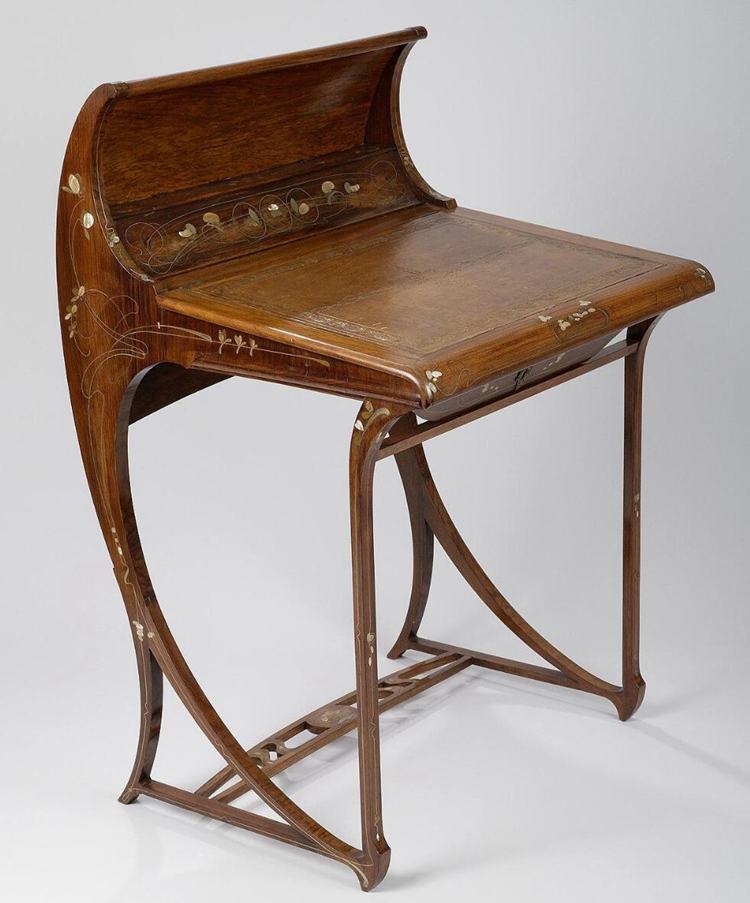




![Where To Sell Antique Furniture In 2022 [Ultimate Guide]](https://www.jacquelinestallone.com/wp-content/uploads/2022/09/Etsy-Your-Place-To-Buy-And-Sell-All-Things-Handmade-600x450.jpg)


